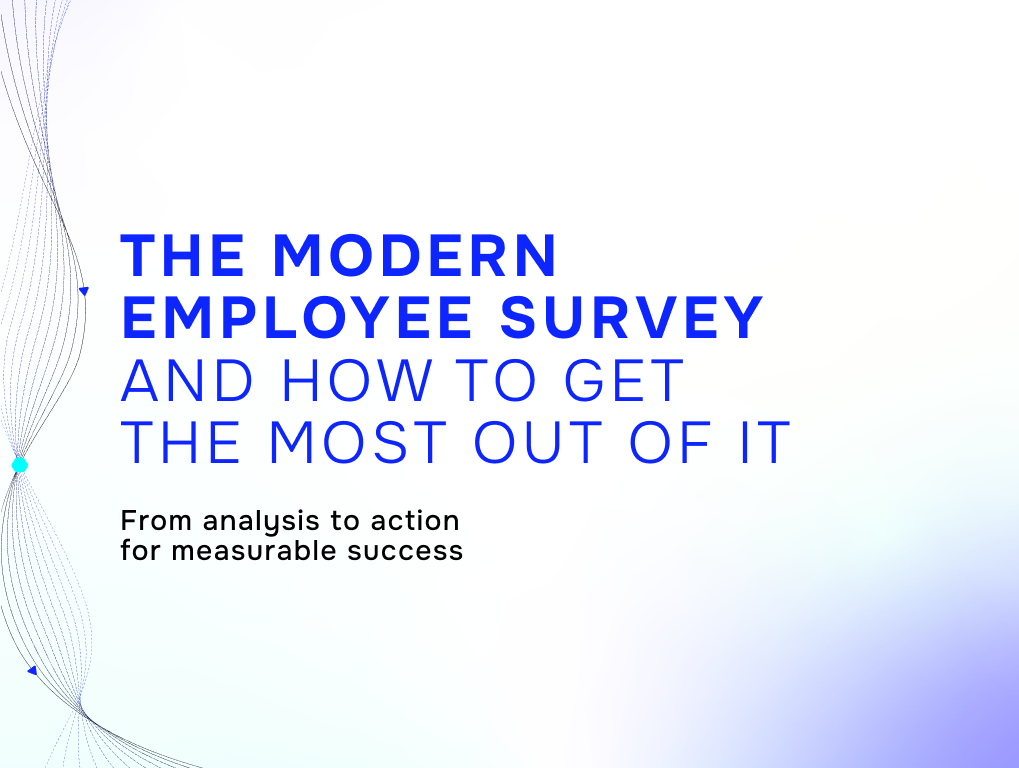Leadership management, engagement, valuable employees leaving your company, employee stress and work-life balance are probably some examples of HR issues you have to deal with on a daily basis. What if I told you that you have at your disposal a powerful tool that can detect these issues before they become problems? The answer is simple: employee surveys.
Welcome to the essential guide for HR managers on employee surveys. Let´s dive in and get a better understanding of the most effective ways to implement company surveys, the types of surveys to use, and the best way to use the data and feedback you receive to improve the experience of your employees and make your organization more efficient.
Whether you’re looking to get started with companies surveys or have already implemented an employee listening strategy, this is your post.
What is an employee survey?
An employee survey is a tool used to capture feedback from employees within the workplace. You will be able to gain insights into employee satisfaction and the general situation of the company’s health in the areas related to Human Resources, so you can make improvements within the organization.
They are usually an online questionnaire that employees can complete to provide their honest opinions and feedback on the workplace and their experience within the organization. Factors such as job satisfaction, leadership, communication, change management, psychological safety, career opportunities, and other relevant topics can be explored.
Employee surveys are a great way to get an insight into how the employees feel about their work environment and the organization as a whole.
By giving employees the opportunity to provide input, it shows that their opinions are valued and that their feedback can be directly actioned for improvements. This can ultimately lead to increased job satisfaction, improved morale, engagement, and productivity.
3 benefits of conducting employee surveys
Employee surveys are a great source of insight into a company’s culture and operations. Conducting company surveys can have many benefits, the most important are:
- Improved communication: when an organization puts the effort into understanding the workplace experiences of their employees, it can significantly improve communication between staff and HR. Employee surveys can help identify issues, and encourage open dialogue about topics that the organization may not otherwise consider.
- Increased morale and productivity: with a greater understanding of their workforce, HR managers can identify what motivates employees and use it to increase morale and productivity in the workplace.
- More effective decision-making: when a company is able to collect and analyze feedback from its staff, they may be able to make better decisions that reflect the preferences, needs and opinions of their employees. HR managers can use this information to recognize areas in which changes are needed, or to make adjustments and create new initiatives.
Types of employee surveys
There are many different types of employee surveys that organizations use to gather feedback from employees. Some common types of employee surveys include:
- Company Health Check: the best diagnosis you could make for your organization (only provided by atwork). A complete survey that gives insight into the 5 most important areas for Human Resources: organization, relationship, leadership, employee development and daily job. It provides a comprehensive view of the organization’s health and a score that can be tracked over time.
- Engagement surveys: these surveys are typically used to measure employees’ overall satisfaction and engagement with their work and the organization. They often include questions about employees’ job satisfaction, motivation, and willingness to recommend the organization to others.
- Pulse surveys: they are shorter and more frequent than traditional employee surveys. They are typically used to measure employees’ current feelings and opinions on a specific topic, issue, or event.
- Deep Dives surveys: they involve conducting extensive and detailed research on a specific subject, exploring its various aspects, and gaining a thorough understanding of its complexities. Some examples: leadership, psychological safety, remote work and change management.
- Customer satisfaction surveys: they can be used to gather feedback about the quality of service/products provided by the organization, and to identify areas that need improvement.

Create a survey
Developing clear objectives
Creating a successful employee survey can be a daunting task. However, you always have the option of relying on an experienced provider of employee feedback collection and analysis -such as atwork- as we have powerful, scientifically proven surveys and a clear methodology. All done for you so you don’t have to waste time on administrative tasks or data analysis.
You need to develop clear objectives for any employee survey that you create. This helps to ensure you have a clear vision of what you’re trying to find out and the action needed to improve your organization’s workplace.
Designing questions
When designing employee surveys, one of the most important aspects to consider is how to create questions that effectively gauge attitudes towards the company, the workplace and organizational issues. It’s not about asking questions, it’s about asking the right questions.
Before formulating any questions for company surveys, it is important to envision the desired outcome. What does the company need to know about the workplace and how will survey results be used? Once this has been established, a series of questions can be formulated to generate the feedback needed.
Start by creating a set of specific questions that cover various aspects of your workplace. Decide what kind of feedback you need from employees in order to gain a better idea of areas that need improvement. Then, from the answers gathered from the survey, you should be able to pinpoint what changes need to be made to make a positive impact on the organization.
There are several factors HR managers should be mindful of when designing questions for employee surveys. The questions should be clear, and should avoid any language that could be considered biased or confidential. Furthermore, the questions should be open-ended as much as possible, and survey takers should have the opportunity to provide additional comments.
The organization of the survey should also be considered, as the way in which questions are sequenced can affect the accuracy of the responses. Creating a clear and succinct survey not only ensures the quality of the information collected, but also how long survey takers take to respond, as overloading a survey can often produce high drop-out rates.

Crafting a survey strategy
Setting the timeframe
One of the most important aspects is setting the timeframe. It is crucial to ensure that the survey period is long enough for the organization to get an adequate response rate and truly reflect the opinions of their employees. It’s also important not to run the survey too long as this can cause a drop in response rate due to people becoming less engaged with the survey.
So, how long should a company survey run for? There are a few considerations to keep in mind. First and foremost, consider the size of your organization and how long it typically takes for employees to complete the survey. Larger organizations will likely require a longer survey process, while smaller companies may be able to implement surveys faster.
Timing can also be a crucial factor. You should always try to select a time when the whole of the organization is active, such as periods between holidays, seasonal breaks or at the start or end of the year. In addition to this, sending out the survey within business hours will give employees more time to respond.
Finally, be sure to communicate the survey schedule to everyone involved. This will ensure employees are aware of the timeframe and can plan accordingly.
Choosing the right survey tool
Choosing the right survey tool for carrying out company surveys is essential for any HR manager. There are a variety of tools available. Online surveys are an easy and effective way of gathering employee opinions, and most provide real-time feedback.
They also require minimal setup and don’t need to be administered manually, which is a huge advantage. Paper surveys are more traditional and can be distributed among employees as is, but they do require more effort to compile and analyze data by hand.
The most important thing is to ensure it aligns with your company culture and values. Make sure any surveys administered are tailored to the organization by tailoring language, questions and formats that suit the business.
Conducting the survey
Creating awareness and generating interest
Surveys are only effective if they are completed, and that means HR professionals need to ensure that their employees are aware of employee surveys and are interested in taking them.
Creating awareness and generating interest in employee surveys is critical to their success. Start by providing employees with:
- A clear and concise overview of what your company surveys are and why they are important.
- Explain why the organization needs the information that can be collected through the survey and how it will be used.
- Provide detailed information about the survey, such as the timeline and when results will be available.
- Explain how the survey will be administered and if the survey is online or paper, what the process will look like.
It’s important to emphasize how employee views will be taken into account. Make sure that your employees know that their opinions matter, that their feedback is valuable, and that their comments will be taken seriously. This can help increase employee engagement in the survey process and provide a real incentive to participate.
By creating awareness and generating interest in employee surveys, HR managers can ensure that their surveys are successful. Through effective communication and by providing the necessary information and incentives, organizations can ensure that their employees are fully aware of and interested in participating in employee surveys. This can result in more accurate and insightful feedback and ultimately help the organization reach its goals.
Collecting data
It is important to design company questionnaires that are tailored to each organization’s unique needs and culture. Ensure that relevant demographic information is retained and that anonymity is respected.
Online questionnaires is an easy and efficient way to collect valuable input from their team members. The process is simple: employees receive an email invitation to complete the questionnaire which they can do at their convenience. Once completed, all data collected through these surveys are compiled and analyzed by HR departments or third-party experts who specialize in employee feedback analysis.
This information can be used to develop strategies that allow Human Resources to anticipate potential problems and implement actions that will make the company grow and succeed.
Analyzing the results
Analyzing survey feedback is only half the battle. To make a real impact, you need to take action based on the feedback you receive. Here are some tips you can take:
- Compare results over time. If you’re conducting employee surveys on a regular basis, compare results over time to see how employees are feeling and what areas may need improvement.
- Look for trends and patterns. When analyzing your data, look for any trends or patterns that emerge. This can help you identify any issues that need to be addressed or areas that are doing well.
- Make sure results are actionable. The whole point of conducting employee surveys is to improve the workplace. So make sure the results of your survey are actionable and can be used to make changes in the workplace.
Analyzing the data can be very time consuming. We are sure that as an HR manager or decision-maker your time is precious and you have to attend to multiple tasks. For this reason, it is important to have a professional partner to provide you with an employee feedback collection and analysis tool to do that work for you.
Choosing an employee feedback collection and analysis tool will save you time, effort, internal costs and get the results you expect. You will be able to analyze the results easily thanks to a Dashboard where all the analysis is reflected.

Establishing an action plan
This is the second part of the battle. It is time for action. This means that once you have the feedback analyzed it is time to make decisions and implement actions.
Choosing a platform (such as the atwork Suite) with AI-recommendation and action plan feature based on the results will be of great help. By identifying patterns in the data, its AI feature can help you pinpoint areas that need improvement and develop concrete plans for addressing them. This is a critical advantage that traditional survey methods cannot match.
This can save you time and allow to focus on other tasks. AI can help to analyze survey results more quickly and accurately.
And finally, it is super important that after you have implemented actions you can follow up on their impact. It is recommended that you opt for a platform that allows you to monitor the impact of your actions over time.
2 common mistakes to avoid in company surveys
While company surveys can be a valuable tool, there are some common mistakes to avoid. These are the most important ones:
- Ignoring feedback: Make sure you take action based on the feedback you receive. Ignoring feedback can lead to disengaged employees and a negative workplace culture.
- Failing to communicate results: share the survey results with employees to show them that their feedback has been heard and that action is being taken.
Some final ideas
Throughout the post we have seen tips for conducting companies surveys that bring value and benefit to the organization. They can help you identify issues and challenges that may be hindering employee retention, change management or engagement, for example. It can also help you identify areas where you can improve communication, collaboration, and teamwork, which can lead to a more positive and productive workplace culture.
Keep in mind that developing clear objectives and creating a set of specific and right questions that cover the key areas of the workplace and organizational issues are very important. Using an experienced provider of employee feedback collection and analysis to help create powerful, scientifically proven surveys and a clear methodology is also critical of the success of your listening strategy.
The atwork Suite provides all you need, a complete platform that allows you to have control of the entire process:
- Different types of scientifically proven questionnaires, with the Company Health Check on the top, which offers you the most complete diagnosis of the health of your organization.
- A powerful Dashboard that collects the analysis of all employee feedback. You will have all the information of the results at the click of a button.
- It saves you time with its powerful AI feature because it offers you an action plan with recommendations to implement based on the feedback collected. Save time and effort!
- And, last but not least, the platform allows you to track the impact of the actions you take over time.
So, if you want to take your organization to the next level, start listening today! Thanks for reading!



